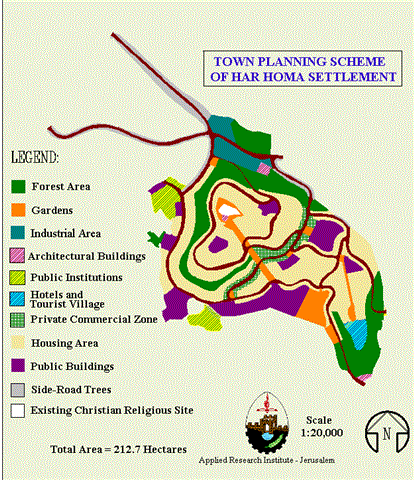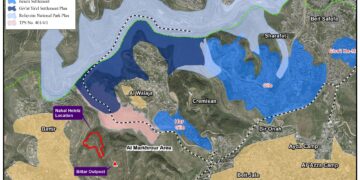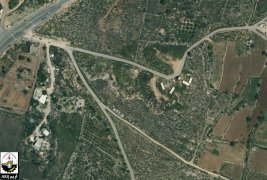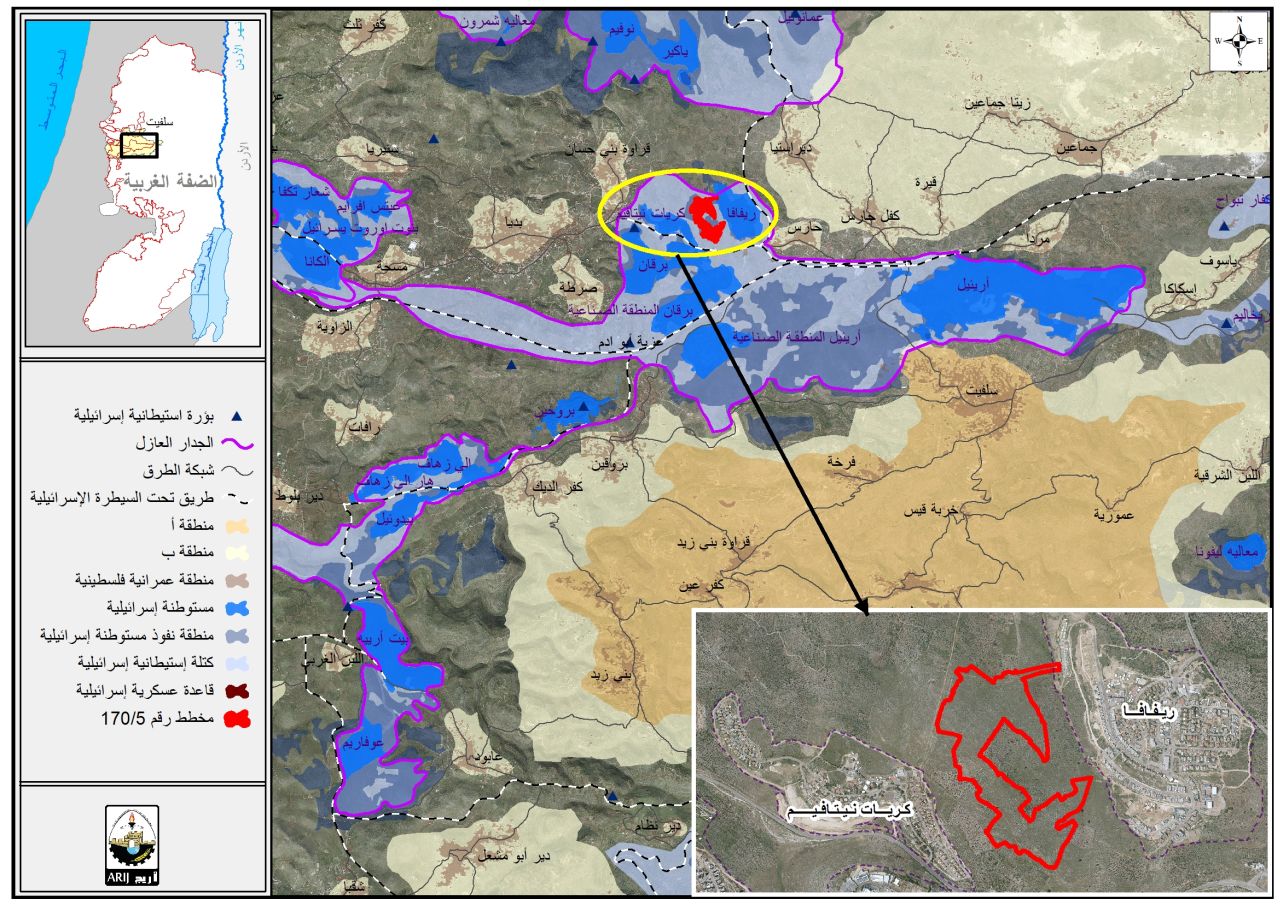Table of Contents
- Abu Ghnaim in Details
- Chronology of Events
- Why Har Homa is an Obstacle to Peace?
- The Myth in Realities in Developing Housing for Palestinians in East Jerusalem
- Destruction of Abu Ghnaim — in Pictures
- Abu Ghnaim in 2003
Abu Ghnaim Mountain
Abu Ghnaim in Details
The Abu Ghnaim mountain is located less than two kilometers north of the city of Bethlehem. The mountain has been historically owned by Palestinians from Bethlehem, Beit Sahour, as well as from the villages of Um Tuba and Sur Baher. The geographical location of the mountain gave it such importance that Israel decided in 1967 to unilaterally carve it out of the Bethlehem District, extending the Jerusalem Municipal boundaries in such a jagged manner as to to include Abu Ghnaim within its scope (Map 1).
Map 1
Abu Ghnaim, with an area of approximately 2 km2, was forested by the Jordanians prior to 1967 and the Israelis after 1967. It presently represents an ecological reserve in an area characterized by a deteriorating environment and increasing desertification. Abu Ghnaim currently hosts around 60,000 pine trees and provides an oasis for several hundreds of precious wild animals and plants. Abu Ghnaim is also the site of a Byzantine Monastery which accommodated pilgrims on their journey between the Church of the Holy Sepulchre in the Old City of Jerusalem and the Nativity Church in Bethlehem.
For many years Abu Ghnaim and its surrounding areas, as seen in Map 2, have been designated by the Israeli Jerusalem Municipality as a 'Green Area': an area in which development is restricted so that the beauty of its landscape, as well as ecological diversity might be preserved. On the ground, most of this area is not green, but rather barren. Israel often uses the umbrella of Green Areas and Town Planning Schemes (TPS) to restrict Palestinian construction in East Jerusalem and prevent the expansion of Palestinian communities located in the vicinity of settlements. An example of another settlement that has been built in a 'Green Area' is the settlement of Reches Shua'fat. (Map 2).
Map 2: Town Planning Scheme of Jerusalem
On 6 June 1991, Israel's Minister of Finance, Mr. Isaac Moda'ee, ordered the expropriation of land on and around the forested mountain of Abu Ghnaim, eventhough large tracts of this land are privately owned by Palestinian families. The expropriation order was based on the Lands Law of 1943 which authorizes the Minister to expropriate lands for public use. The term, 'public use', is used to condone the construction of settlements for the sole use of Israeli Jews. Neither Palestinians with Israeli citizenship nor Palestinians from the occupied territories are allowed to live in settlement housing.
The Israeli government planning scheme of Har Homa settlement includes the construction of at least 6,500 housing units in high-rise structures with standard infrastructure such as roads, schools, and shops, in addition to hotels, a tourist village, and industrial zones (see table below). The new settlement is expected to accommodate thirty to forty thousands Jewish settlers.
Planning Scheme of Har Homa Settlement
|
Land Use |
Area
Hectares |
Area
(%) |
| Industrial zone | 71.60 | 3.44% |
| Forest area | 356.40 | 16.75% |
| Roads | 277.60 | 13.12% |
| Side road trees (Panorama) | 103.40 | 4.84% |
| Public institutions | 70.60 | 3.31% |
| Built-up area | 797.60 | 37.50% |
| Gardens | 106.00 | 4.95% |
| Public buildings | 234.20 | 11.01% |
| Hotels and tourist village | 29.00 | 1.35% |
| Private commercial zone | 56.20 | 2.63% |
| Architectural construction | 13.65 | 0.63% |
| Existing Christian religious site | 10.50 | 0.47% |
| Total | 2126.75 | 100.00% |
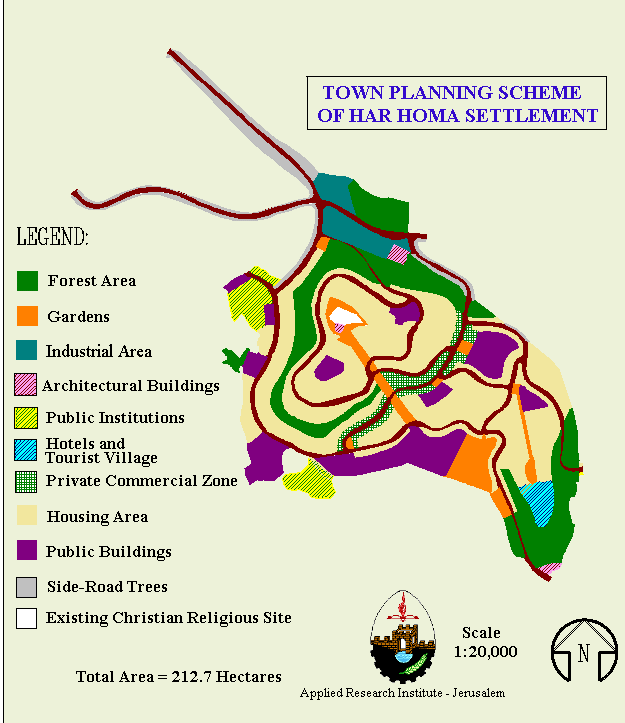 |
Map 3: The Planning Scheme of Har Homa
Through the Israeli judicial system, Palestinians were able to defer the construction of the Israeli settlement of Har Homa on the Abu Ghnaim mountain through mid 1996. After this time, all legal objections were dismissed by the Israeli Supreme Court of Justice and construction of the settlement is expected to start within weeks. The construction of Har Homa settlement will destroy the Abu Ghnaim ecosystem and flatten most of its trees, leading to the extinction of many endemic wild plants and animals. Despite the Israeli 1962 Forest Ordinance protects forested areas similar to that of Abu Ghnaim and declares pine trees as protected trees, Har Homa settlement was approved by the Israeli Government without consideration of performing an environmental impact assessment.
The Israeli government has already begun construction of a fenced military by-pass road to provide access to Abu Ghnaim mountain. The by-pass road is designed to connect Har Homa with the settlement of Gilo and create a new border for southern Jerusalem. Israeli engineers designed a rather difficult and lengthy road, which will carve further areas out of the Bethlehem District, engulfing large tracts of fertile Palestinian agricultural land (Map 4).
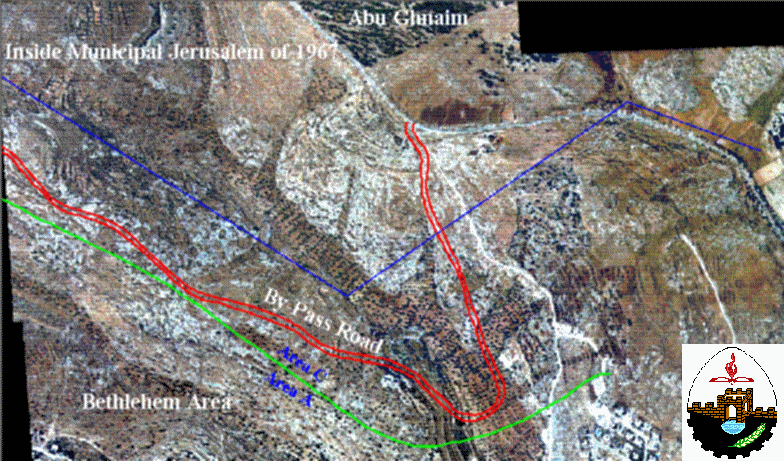 |
Map 4: Aerial Photo of the By-pass Road
Why Har Homa is an Obstacle to Peace?
The building of Har Homa settlement will create a new reality in the Bethlehem and Jerusalem area which will have detrimental consequences on the welfare of Palestinian communities and on the peace process. The main reasons why Har Homa construction should be opposed are as follows:
1. The Suffocation of Bethlehem and its Neighboring Communities.
The tri-cities Bethlehem, Beit Jala, and Beit Sahour will be left with little land to accommodate natural population growth if Har Homa settlement is constructed. Whereas, the Har Homa settlement would draw the northern boundary of the Bethlehem area, the Gush Etzion bloc of settlements limits Bethlehem's southern expanse. From the west, Bethlehem is surrounded by Bitar Ilite settlement as well as two by-pass roads, from the East by Taqoa settlement and a third by-pass road. The building of Har Homa and the fenced military by-pass road which will connect it with the neighboring Gilo settlement will deprive Bethlehem of the only land left for its future development. This by-pass road will also shift the border of Jerusalem further south and deeper into the Bethlehem area. It is worth mentioning that in 1967 Israel unilaterally expanded the borders of East Jerusalem to include about 16 km2 from Bethlehem. Map 5 shows the limitations on the expansion of Bethlehem imposed by Israel.
 |
Map 5: Restrictions on the Development of Bethlehem Area
2. The Elimination of Territorial Continuity between Bethlehem and Palestinian East Jerusalem:
The building Har Homa settlement and the fenced military by-pass road which will connect it with the neighboring settlement of Gilo will create a physical barrier, disconnecting Bethlehem from Jerusalem. The fenced military by-pass road will not only cut off Palestinian agricultural lands from Bethlehem but will also block the main road connecting Bethlehem with Palestinian East Jerusalem (Map 6). It will also detach Bethlehmites from access to East Jerusalem — their religious, economic, and cultural center.
 |
Map 6: Har Homa and Military By-Pass Road (Aerial Photo)
3. The Desecration of Christian Holy Sites:
The Abu Ghnaim mountain hosts many Christian holy sites, including St. Theodore's Well, the 5th and 6th century Byzantine monastery and church of Bir Qadisum, which marks the place where St. Mary dismounted before giving birth to Jesus. Some of these ruins might be destroyed during the development of the Har Homa settlement and disputes may arise as to the ownership and maintenance of these Christian sites.
The closeness of Abu Ghnaim mountain to the Christian traditional site of the Shepherd's Fields necessitates that the forested mountain be left in tact so as to preserve the landscape of this biblical setting. The removal of the trees and replacing them with modern western-style houses and industrial parks will undoubtedly alter the character of the area adjacent to the Shepherd's Fields.
4. Deprivation of Bethlehemites of Economic Resources:
The Har Homa settlement will ensure that Israel deprives the Palestinians of Bethlehem of their main source of income: tourism. The Har Homa project includes the building of a tourist village, Bethlehem Israel, to attract the Christian tourists who come to visit the Church of Nativity in Bethlehem. These pilgrims coming on Israeli tours, who are mostly guided by Israeli tour guides, will be taken to the Har Homa tourist village without being given the opportunity to shop in Bethlehem or pray with the local Palestinian Christians. For this purpose, Israel is working hard to complete the Har Homa settlement before the year 2000. In 2000, it is expected that far over 5 million Christians from all over the world will visit Bethlehem to celebrate with the local Palestinian Christians in Bethlehem, the 2000th anniversary of Christianity and the Christ.
The Byzantine monastery on the top of Abu Ghnaim mountains would remain on site. This monastery would become a showpiece, exploited for tourist revenue in the same fashion as the Byzantine Church which is located in the Middle of Ma'ale Adumim settlement. Thus, Israel, rather than the local Christian community, would benefit from the tourist development of these sites.
5. Violation of Political Commitment to the Peace Process:
Upon Israeli obstinacy, the issue of sovereignty over Jerusalem was overlooked in the Oslo II Interim Agreement and was postponed until the final status negotiations between the Israelis and Palestinians, which have been stalled since their initiation in May 1996. In the meantime, the Israeli government has not stopped its unilateral practices in Jerusalem by which it creates de facto realities on the ground. These de facto realities are clearly affecting the outcome of the negotiations on the final status of Jerusalem, to favor Israel, an action that is in total violation to United Nations' resolutions, particularly 298 (Resolution 298) and 242, as well as standing Palestinian-Israeli Oslo Agreements. Chapter two, Article 31, item 7 of the Israeli-Palestinian Interim Agreement on the West Bank and the Gaza Strip (Oslo II) states that "neither sides shall initiate or take any step that will change the status of the West Bank and the Gaza Strip pending the outcome of the permanent status negotiations"
If the Har Homa settlement is built it will complete a ring of Jewish settlements around Jerusalem, most of which is in the still-occupied West Bank. By building the Har Homa settlement, Israel will seal off Jerusalem and dismiss any Palestinian efforts to negotiate on the final status of the city. Such action will not only spark a wave of discontent among Palestinians but will permanently disable the peace process.
The Myth in Realities in Developing Housing for Palestinians in East Jerusalem
In order to absorb some of the international pressure to stop the construction of Jewish-only housing units on Abu Ghnaim mountain, Israel included in its Har Homa settlement package the building for Palestinians in East Jerusalem. For this purpose, Israel approved a budget of US$ 50 million. However, this amount will not be used for building houses, as was declared by Israel. The Israeli The Jerusalem Post wrote on 7 March 1997 "Yet the money is still tied up in red tape. .. But Israel does not build for the Arabs in Jerusalem. As was pointed out to Netanyahu by Deputy Mayor Uri Lupoliansky, unlike the case of Har Homa, which is slated to become a giant public housing project, money allocated for East Jerusalem is for infrastructure only. The Arabs must build homes for themselves".
The clarification of myths and realities in the Israeli proposal for developing Palestinian housing in East Jerusalem is well explained by the American Peace Now. CLICK HERE for a detailed Environmental Impact Assessment of the Har Homa Settlement
Prepared by:
The Applied Research Institute – Jerusalem


